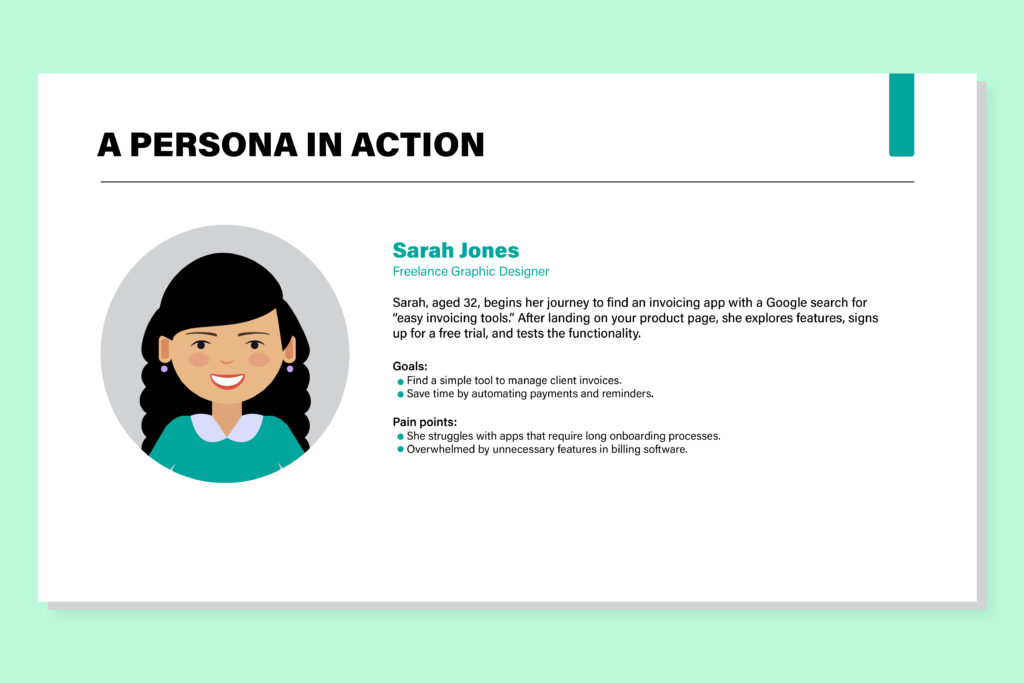From Insights to Action: How User Journey Mapping Elevates Your UX Game
Ever felt frustrated while navigating a website or app, wondering why it couldn’t just work? Chances are, the creators didn’t fully understand your journey as a user. This is where User Journey Mapping becomes a game-changer. It’s not just about understanding your users—it’s about creating experiences they’ll love and remember.
What is User Journey Mapping?
Imagine having a map that shows every step your customers take when interacting with your product or service, from their first visit to post-purchase. That’s User Journey Mapping. It’s a tool that visualizes users’ emotions, touchpoints, and challenges throughout their interaction with your brand.
Why It Matters
Did you know 67% of customers will abandon a product if their experience isn’t smooth? User Journey Mapping helps teams pinpoint friction and create seamless, engaging paths for users.

Persona in action
Sarah’s user journey for finding an invoicing app starts with a Google search for “easy invoicing tools.” After landing on your product page, she explores features, signs up for a free trial, and tests the functionality. If the journey feels smooth—quick account setup, intuitive interface, and instant support—Sarah converts into a paying customer. But if she hits friction—like unclear navigation or excessive clicks—she leaves for a competitor.
By mapping Sarah’s journey, you can identify her touchpoints, such as searching for help articles or interacting with your support team, and optimize these to deliver value at every stage.
Key Benefits of User Journey Mapping
- Empathy in action: Walk in your users’ shoes and feel their frustrations and joys.
- Strategic clarity: Align marketing, design, and development teams with user-centric goals.
- Better conversions: Solve customer pain points to improve loyalty and sales.
A Real-Life Case: The Google Drive Experience
When Google Drive launched, users faced confusion during file-sharing. By mapping the user journey, the team discovered that unclear sharing permissions caused frustration. Their solution? A streamlined UI with clear options like “Anyone with the link.” The result? Fewer complaints and increased user satisfaction.

Google drive “Anyone with the link” example
How to Create a Winning User Journey Map
- Start with Research: Collect data through surveys, user interviews, and analytics.
- Define Personas: Understand your audience by creating user profiles like Sarah.
- Map the Journey Stages: Break the journey into phases, such as awareness, consideration, and retention.
- Identify Touchpoints: Highlight all interactions—online and offline.
- Spot Emotions and Pain Points: Note where users feel excitement, confusion and frustration.
- Iterate and Improve: Use your map to make data-driven enhancements.
User Journey Mapping isn’t just a tool—it’s your secret weapon for delivering experiences that resonate with users. Whether you’re launching a startup or optimizing an existing product, understanding the user journey can unlock new opportunities for growth and innovation.

13 comments
canada drogues.com kamagra
August 17, 2025 at 8:11 amacheter kamagra sans ordonnance
sans ordonnance kamagra beau prix pas
buy enclomiphene american pharmacy
August 17, 2025 at 8:34 amordering enclomiphene toronto canada
cheapest buy enclomiphene cheap canada
cheapest no prescription needed androxal cialis
August 17, 2025 at 11:06 amcheap androxal cheap with fast shipping
ordering androxal generic pricing
purchase dutasteride purchase line
August 17, 2025 at 1:01 pmcheap dutasteride cost new zealand
ordering dutasteride generic mexico
purchase flexeril cyclobenzaprine canada over the counter
August 17, 2025 at 1:02 pmpurchase flexeril cyclobenzaprine generic version
flexeril cyclobenzaprine ups fedex shipping
purchase fildena canada generic
August 17, 2025 at 2:07 pmonline order fildena
fildena 25 mg price
discount gabapentin cheap in uk
August 17, 2025 at 2:38 pmorder gabapentin generic in usa
buy gabapentin no prescription online
discount itraconazole cheap wholesale
August 17, 2025 at 3:40 pmordering itraconazole cheap store
ordering itraconazole generic cheap
purchase discount staxyn no rx
August 18, 2025 at 2:20 ambuy cheap staxyn generic uk next day delivery
buying staxyn generic staxyns
how to buy avodart generic london
August 18, 2025 at 3:48 amavodart canada pharmacy
discount avodart canada price
how to order rifaximin cheap drugs
August 18, 2025 at 5:32 amorder rifaximin generic canadian
low cost generic rifaximin
online order xifaxan generic from the uk
August 18, 2025 at 5:50 ampurchase xifaxan uk how to get
order xifaxan generic online pharmacy
nejlevnější usa kamagra
August 18, 2025 at 9:08 amkamagra přenocování cod bez lékařského předpisu
generic kamagra online příští den
Comments are closed.